Spatial and Temporal Evolution of Land Use and the Response of Habitat Quality in Wusu, China
Abstract
1. Introduction
2. Materials and Methods
2.1. Study Area
2.2. Data Resources
2.3. Methods
2.3.1. Land Use Transfer Matrix
2.3.2. InVEST Model
2.3.3. Assessment of the Response of HQ to Land Use Change
2.3.4. GeoDetector
3. Results
3.1. Land Use Change Matrix
3.2. HQ Change
3.3. Response of HQ to Land Use Change
3.4. Impact Factors of HQ in Typical Sample Areas
4. Discussion
4.1. Land Use Change
4.2. Impact Factors of HQ
4.3. The Reasonable Ways of Land Use
5. Conclusions
Author Contributions
Funding
Institutional Review Board Statement
Informed Consent Statement
Data Availability Statement
Conflicts of Interest
References
- Finlayson, M. Millennium Ecosystem Assessment. In Ecosystems and Human Well-Being: Wetlands and Water; World Resources Institute: Washington, DC, USA, 2016; pp. 1–5. ISBN 978-94-007-6172-8. [Google Scholar]
- Yao, J.; Zhao, Y.; Chen, Y.; Yu, X.; Zhang, R. Multi-Scale Assessments of Droughts: A Case Study in Xinjiang, China. Sci. Total Environ. 2018, 630, 444–452. [Google Scholar] [CrossRef]
- Liu, Y.; Hu, W.; Wang, S.; Sun, L. Eco-Environmental Effects of Urban Expansion in Xinjiang and the Corresponding Mechanisms. Eur. J. Remote Sens. 2020, 54, 132–144. [Google Scholar] [CrossRef]
- Xu, L.; Fan, X.; Wang, W.; Xu, L.; Duan, Y.; Shi, R. Renewable and Sustainable Energy of Xinjiang and Development Strategy of Node Areas in the “Silk Road Economic Belt”. Renew. Sustain. Energy Rev. 2017, 79, 274–285. [Google Scholar] [CrossRef]
- Bahtebay, J.; Zhang, F.; Ariken, M.; Chan, N.W.; Tan, M.L. Evaluation of the Coordinated Development of Urbanization-Resources-Environment from the Incremental Perspective of Xinjiang, China. J. Clean. Prod. 2021, 325, 129309. [Google Scholar] [CrossRef]
- Peng, B.; Sheng, X.; Wei, G. Does Environmental Protection Promote Economic Development? From the Perspective of Coupling Coordination between Environmental Protection and Economic Development. Environ. Sci. Pollut. Res. 2020, 27, 39135–39148. [Google Scholar] [CrossRef]
- Wu, H.; Peng, D.; Wang, L. Model for Sustainable Development Based on System Dynamics and Energy–Economy–Environment Coordination: A Case Study of Beijing, China. Energy Sci. Eng. 2021, 9, 828–842. [Google Scholar] [CrossRef]
- Chen, M.; Bai, Z.; Wang, Q.; Shi, Z. Habitat Quality Effect and Driving Mechanism of Land Use Transitions: A Case Study of Henan Water Source Area of the Middle Route of the South-to-North Water Transfer Project. Land 2021, 10, 796. [Google Scholar] [CrossRef]
- He, C.; Huang, Z.; Wang, R. Land Use Change and Economic Growth in Urban China: A Structural Equation Analysis. Urban Stud. 2014, 51, 2880–2898. [Google Scholar] [CrossRef]
- Aneseyee, A.B.; Noszczyk, T.; Soromessa, T.; Elias, E. The InVEST Habitat Quality Model Associated with Land Use/Cover Changes: A Qualitative Case Study of the Winike Watershed in the Omo-Gibe Basin, Southwest Ethiopia. Remote Sens. 2020, 12, 1103. [Google Scholar] [CrossRef]
- Zhao, G.; Liu, J.; Kuang, W.; Ouyang, Z.; Xie, Z. Disturbance Impacts of Land Use Change on Biodiversity Conservation Priority Areas across China: 1990–2010. J. Geogr. Sci. 2015, 25, 515–529. [Google Scholar] [CrossRef]
- Riedler, B.; Lang, S. A Spatially Explicit Patch Model of Habitat Quality, Integrating Spatio-Structural Indicators. Ecol. Indic. 2018, 94, 128–141. [Google Scholar] [CrossRef]
- Gomes, E.; Inácio, M.; Bogdzevič, K.; Kalinauskas, M.; Karnauskaitė, D.; Pereira, P. Future Scenarios Impact on Land Use Change and Habitat Quality in Lithuania. Environ. Res. 2021, 197, 111101. [Google Scholar] [CrossRef] [PubMed]
- Hack, J.; Molewijk, D.; Beißler, M.R. A Conceptual Approach to Modeling the Geospatial Impact of Typical Urban Threats on the Habitat Quality of River Corridors. Remote Sens. 2020, 12, 1345. [Google Scholar] [CrossRef]
- Dai, L.; Li, S.; Lewis, B.J.; Wu, J.; Yu, D.; Zhou, W.; Zhou, L.; Wu, S. The Influence of Land Use Change on the Spatial–Temporal Variability of Habitat Quality between 1990 and 2010 in Northeast China. J. For. Res. 2019, 30, 2227–2236. [Google Scholar] [CrossRef]
- Liu, Y.; Huang, X.; Yang, H.; Zhong, T. Environmental Effects of Land-Use/Cover Change Caused by Urbanization and Policies in Southwest China Karst Area—A Case Study of Guiyang. Habitat Int. 2014, 44, 339–348. [Google Scholar] [CrossRef]
- Wang, B.; Cheng, W. Effects of Land Use/Cover on Regional Habitat Quality under Different Geomorphic Types Based on InVEST Model. Remote Sens. 2022, 14, 1279. [Google Scholar] [CrossRef]
- Mengist, W.; Soromessa, T.; Feyisa, G.L. Landscape Change Effects on Habitat Quality in a Forest Biosphere Reserve: Implications for the Conservation of Native Habitats. J. Clean. Prod. 2021, 329, 129778. [Google Scholar] [CrossRef]
- Paz, D.B.; Henderson, K.; Loreau, M. Agricultural Land Use and the Sustainability of Social-Ecological Systems. Ecol. Model. 2020, 437, 109312. [Google Scholar] [CrossRef]
- Liu, Y.; Xu, N.; Li, Z.; Wang, J.; Zeng, H. Differential Impact of Constructed Land Expansion on Ecosystem Health: A Case Study in the Coastal Region of the East China Sea. Ecol. Eng. 2022, 180, 106665. [Google Scholar] [CrossRef]
- Hung, H.-J.; Lo, W.-C.; Chen, C.-N.; Tsai, C.-H. Fish’ Habitat Area and Habitat Transition in a River under Ordinary and Flood Flow. Ecol. Eng. 2022, 179, 106606. [Google Scholar] [CrossRef]
- Hillard, E.M.; Nielsen, C.K.; Groninger, J.W. Swamp Rabbits as Indicators of Wildlife Habitat Quality in Bottomland Hardwood Forest Ecosystems. Ecol. Indic. 2017, 79, 47–53. [Google Scholar] [CrossRef]
- Almasieh, K.; Cheraghi, M. Habitat Suitability, Core Habitats and Diversity Hotspots for the Conservation of the Mustelid Species in Iran. Glob. Ecol. Conserv. 2022, 36, e02120. [Google Scholar] [CrossRef]
- Leal, C.G.; Pompeu, P.S.; Gardner, T.A.; Leitão, R.P.; Hughes, R.M.; Kaufmann, P.R.; Zuanon, J.; de Paula, F.R.; Ferraz, S.F.B.; Thomson, J.R.; et al. Multi-Scale Assessment of Human-Induced Changes to Amazonian Instream Habitats. Landsc. Ecol. 2016, 31, 1725–1745. [Google Scholar] [CrossRef]
- Torn, K.; Herkül, K.; Martin, G.; Oganjan, K. Assessment of Quality of Three Marine Benthic Habitat Types in Northern Baltic Sea. Ecol. Indic. 2017, 73, 772–783. [Google Scholar] [CrossRef]
- Rehitha, T.V.; Vineetha, G.; Madhu, N.V. Ecological Habitat Quality Assessment of a Tropical Estuary Using Macrobenthic Functional Characteristics and Biotic Indices. Environ. Sci. Pollut. Res. 2022, 29, 47629–47646. [Google Scholar] [CrossRef]
- Tang, F.; Wang, L.; Guo, Y.; Fu, M.; Huang, N.; Duan, W.; Luo, M.; Zhang, J.; Li, W.; Song, W. Spatio-Temporal Variation and Coupling Coordination Relationship between Urbanisation and Habitat Quality in the Grand Canal, China. Land Use Policy 2022, 117, 106119. [Google Scholar] [CrossRef]
- Sun, X.; Jiang, Z.; Liu, F.; Zhang, D. Monitoring Spatio-Temporal Dynamics of Habitat Quality in Nansihu Lake Basin, Eastern China, from 1980 to 2015. Ecol. Indic. 2019, 102, 716–723. [Google Scholar] [CrossRef]
- Song, S.; Liu, Z.; He, C.; Lu, W. Evaluating the Effects of Urban Expansion on Natural Habitat Quality by Coupling Localized Shared Socioeconomic Pathways and the Land Use Scenario Dynamics-Urban Model. Ecol. Indic. 2020, 112, 106071. [Google Scholar] [CrossRef]
- Yang, Y. Evolution of Habitat Quality and Association with Land-Use Changes in Mountainous Areas: A Case Study of the Taihang Mountains in Hebei Province, China. Ecol. Indic. 2021, 129, 107967. [Google Scholar] [CrossRef]
- Wang, Y.; Ye, A.; Peng, D.; Miao, C.; Di, Z.; Gong, W. Spatiotemporal Variations in Water Conservation Function of the Tibetan Plateau under Climate Change Based on InVEST Model. J. Hydrol. Reg. Stud. 2022, 41, 101064. [Google Scholar] [CrossRef]
- Zhou, Y.; Li, X.; Liu, Y. Land Use Change and Driving Factors in Rural China during the Period 1995-2015. Land Use Policy 2020, 99, 105048. [Google Scholar] [CrossRef]
- Climatic Characteristics_Website of Wusu Municipal People’s Government. Available online: http://www.xjws.gov.cn/zjws/zrdl/content_1979 (accessed on 21 December 2022).
- Liu, B.; Pan, L.; Qi, Y.; Guan, X.; Li, J. Land Use and Land Cover Change in the Yellow River Basin from 1980 to 2015 and Its Impact on the Ecosystem Services. Land 2021, 10, 1080. [Google Scholar] [CrossRef]
- Yang, H.; Zhong, X.; Deng, S.; Nie, S. Impact of LUCC on Landscape Pattern in the Yangtze River Basin during 2001–2019. Ecol. Inform. 2022, 69, 101631. [Google Scholar] [CrossRef]
- Wang, X.; Cong, P.; Jin, Y.; Jia, X.; Wang, J.; Han, Y. Assessing the Effects of Land Cover Land Use Change on Precipitation Dynamics in Guangdong–Hong Kong–Macao Greater Bay Area from 2001 to 2019. Remote Sens. 2021, 13, 1135. [Google Scholar] [CrossRef]
- De Rosa, M.; Odgaard, M.V.; Staunstrup, J.K.; Knudsen, M.T.; Hermansen, J.E. Identifying Land Use and Land-Use Changes (LULUC): A Global LULUC Matrix. Environ. Sci. Technol. 2017, 51, 7954–7962. [Google Scholar] [CrossRef]
- Tallis, H.; Ricketts, T.H.; Daily, G.C.; Polasky, S. Natural Capital: Theory and Practice of Mapping Ecosystem Services; Oxford University Press: Oxford, UK, 2011; ISBN 978-0-19-958899-2. [Google Scholar]
- Li, M.; Zhou, Y.; Xiao, P.; Tian, Y.; Huang, H.; Xiao, L. Evolution of Habitat Quality and Its Topographic Gradient Effect in Northwest Hubei Province from 2000 to 2020 Based on the InVEST Model. Land 2021, 10, 857. [Google Scholar] [CrossRef]
- Chiang, L.-C.; Lin, Y.-P.; Huang, T.; Schmeller, D.S.; Verburg, P.H.; Liu, Y.-L.; Ding, T.-S. Simulation of Ecosystem Service Responses to Multiple Disturbances from an Earthquake and Several Typhoons. Landsc. Urban Plan. 2014, 122, 41–55. [Google Scholar] [CrossRef]
- Moreira, M.; Fonseca, C.; Vergílio, M.; Calado, H.; Gil, A. Spatial Assessment of Habitat Conservation Status in a Macaronesian Island Based on the InVEST Model: A Case Study of Pico Island (Azores, Portugal). Land Use Policy 2018, 78, 637–649. [Google Scholar] [CrossRef]
- Chu, L.; Sun, T.; Wang, T.; Li, Z.; Cai, C. Evolution and Prediction of Landscape Pattern and Habitat Quality Based on CA-Markov and InVEST Model in Hubei Section of Three Gorges Reservoir Area (TGRA). Sustainability 2018, 10, 3854. [Google Scholar] [CrossRef]
- Xu, L.; Chen, S.S.; Xu, Y.; Li, G.; Su, W. Impacts of Land-Use Change on Habitat Quality during 1985–2015 in the Taihu Lake Basin. Sustainability 2019, 11, 3513. [Google Scholar] [CrossRef]
- Wang, J.; Li, X.; Christakos, G.; Liao, Y.; Zhang, T.; Gu, X.; Zheng, X. Geographical Detectors-Based Health Risk Assessment and Its Application in the Neural Tube Defects Study of the Heshun Region, China. Int. J. Geogr. Inf. Sci. 2010, 24, 107–127. [Google Scholar] [CrossRef]
- Zhao, R.; Zhan, L.; Yao, M.; Yang, L. A Geographically Weighted Regression Model Augmented by Geodetector Analysis and Principal Component Analysis for the Spatial Distribution of PM2.5. Sustain. Cities Soc. 2020, 56, 102106. [Google Scholar] [CrossRef]
- Zhao, Y.; Cao, J.; Zhang, X.; Zhang, M. Analyzing the Characteristics of Land Use Distribution in Typical Village Transects at Chinese Loess Plateau Based on Topographical Factors. Open Geosci. 2022, 14, 429–442. [Google Scholar] [CrossRef]
- Chen, L.; Wang, Q. Spatio-Temporal Evolution and Influencing Factors of Land Use in Tibetan Region: 1995–2025. Earth Sci. Inform. 2021, 14, 1821–1832. [Google Scholar] [CrossRef]
- Punzo, G.; Castellano, R.; Bruno, E. Using Geographically Weighted Regressions to Explore Spatial Heterogeneity of Land Use Influencing Factors in Campania (Southern Italy). Land Use Policy 2022, 112, 105853. [Google Scholar] [CrossRef]
- Uisso, A.M.; Tanrıvermiş, H. Driving Factors and Assessment of Changes in the Use of Arable Land in Tanzania. Land Use Policy 2021, 104, 105359. [Google Scholar] [CrossRef]
- Xie, W.; Jin, W.; Chen, K.; Wu, J.; Zhou, C. Land Use Transition and Its Influencing Factors in Poverty-Stricken Mountainous Areas of Sangzhi County, China. Sustainability 2019, 11, 4915. [Google Scholar] [CrossRef]
- Zhang, Y.; Li, Y.; Lv, J.; Wang, J.; Wu, Y. Scenario Simulation of Ecological Risk Based on Land Use/Cover Change—A Case Study of the Jinghe County, China. Ecol. Indic. 2021, 131, 108176. [Google Scholar] [CrossRef]
- Katusiime, J.; Schütt, B. Integrated Water Resources Management Approaches to Improve Water Resources Governance. Water 2020, 12, 3424. [Google Scholar] [CrossRef]
- Guo, J.; Xu, H.; Zhang, G.; Yuan, K.; Ling, H. The Enhanced Management of Water Resources Improves Ecosystem Services in a Typical Arid Basin. Sustainability 2020, 12, 8802. [Google Scholar] [CrossRef]
- Mitri, G.; Nasrallah, G.; Gebrael, K.; Nassar, M.B.; Dagher, M.A.; Nader, M.; Masri, N.; Choueiter, D. Assessing Land Degradation and Identifying Potential Sustainable Land Management Practices at the Subnational Level in Lebanon. Environ. Monit. Assess. 2019, 191, 567. [Google Scholar] [CrossRef]
- Lathuillière, M.J.; Solvik, K.; Macedo, M.N.; Graesser, J.; Miranda, E.J.; Couto, E.G.; Johnson, M.S. Cattle Production in Southern Amazonia: Implications for Land and Water Management. Environ. Res. Lett. 2019, 14, 114025. [Google Scholar] [CrossRef]
- Malek, Ž.; Verburg, P.H.; Geijzendorffer, I.R.; Bondeau, A.; Cramer, W. Global Change Effects on Land Management in the Mediterranean Region. Glob. Environ. Chang. 2018, 50, 238–254. [Google Scholar] [CrossRef]
- Adenle, A.A.; Speranza, C.I. Social-Ecological Archetypes of Land Degradation in the Nigerian Guinea Savannah: Insights for Sustainable Land Management. Remote Sens. 2021, 13, 32. [Google Scholar] [CrossRef]
- Chen, W.; Xu, Q.; Zhao, K.; Zhou, X.; Li, S.; Wang, J.; Wang, X.; Xu, J. Spatial Analysis of Land-Use Management for Gully Land Consolidation on the Loess Plateau in China. Ecol. Indic. 2020, 117, 106633. [Google Scholar] [CrossRef]
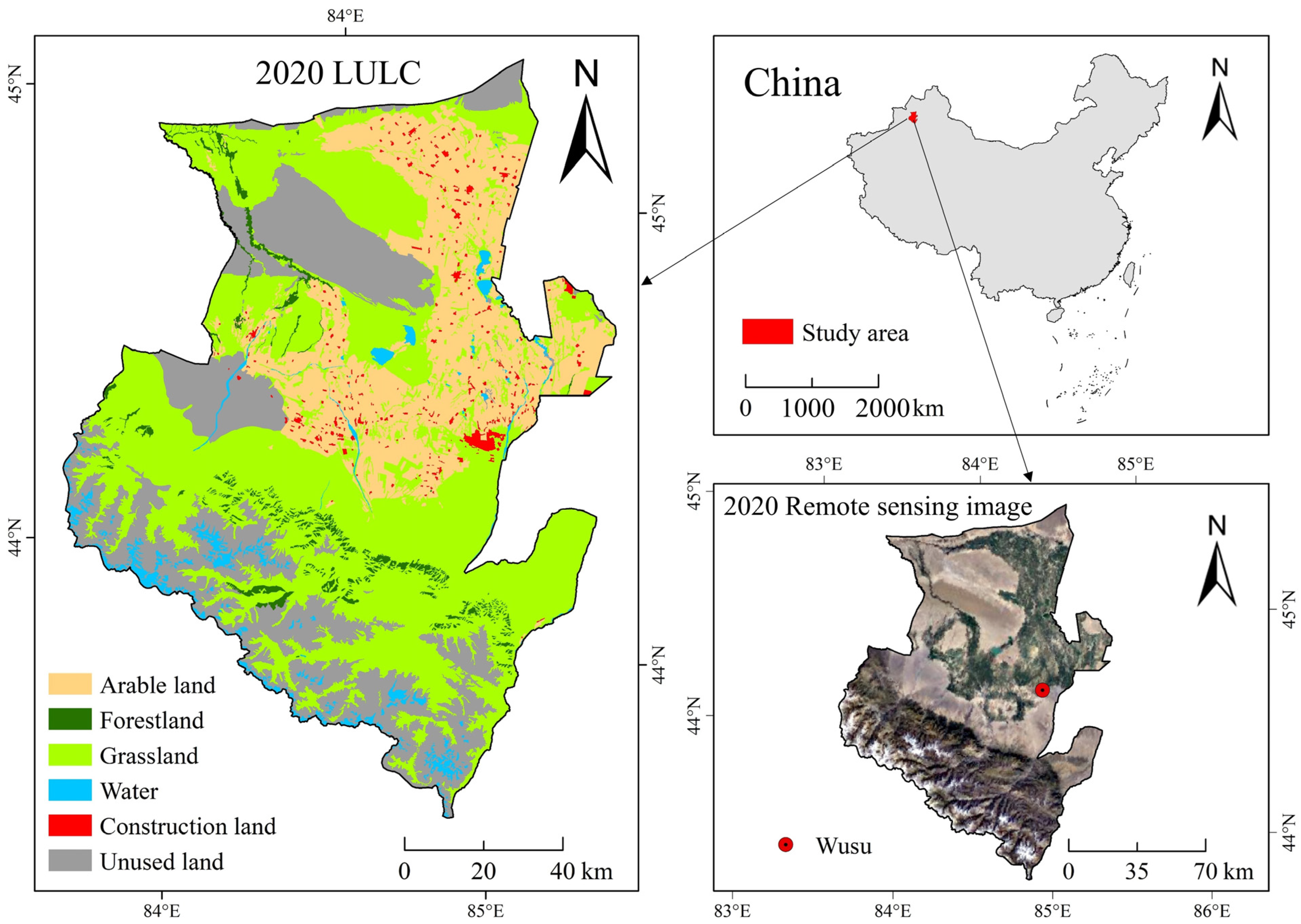
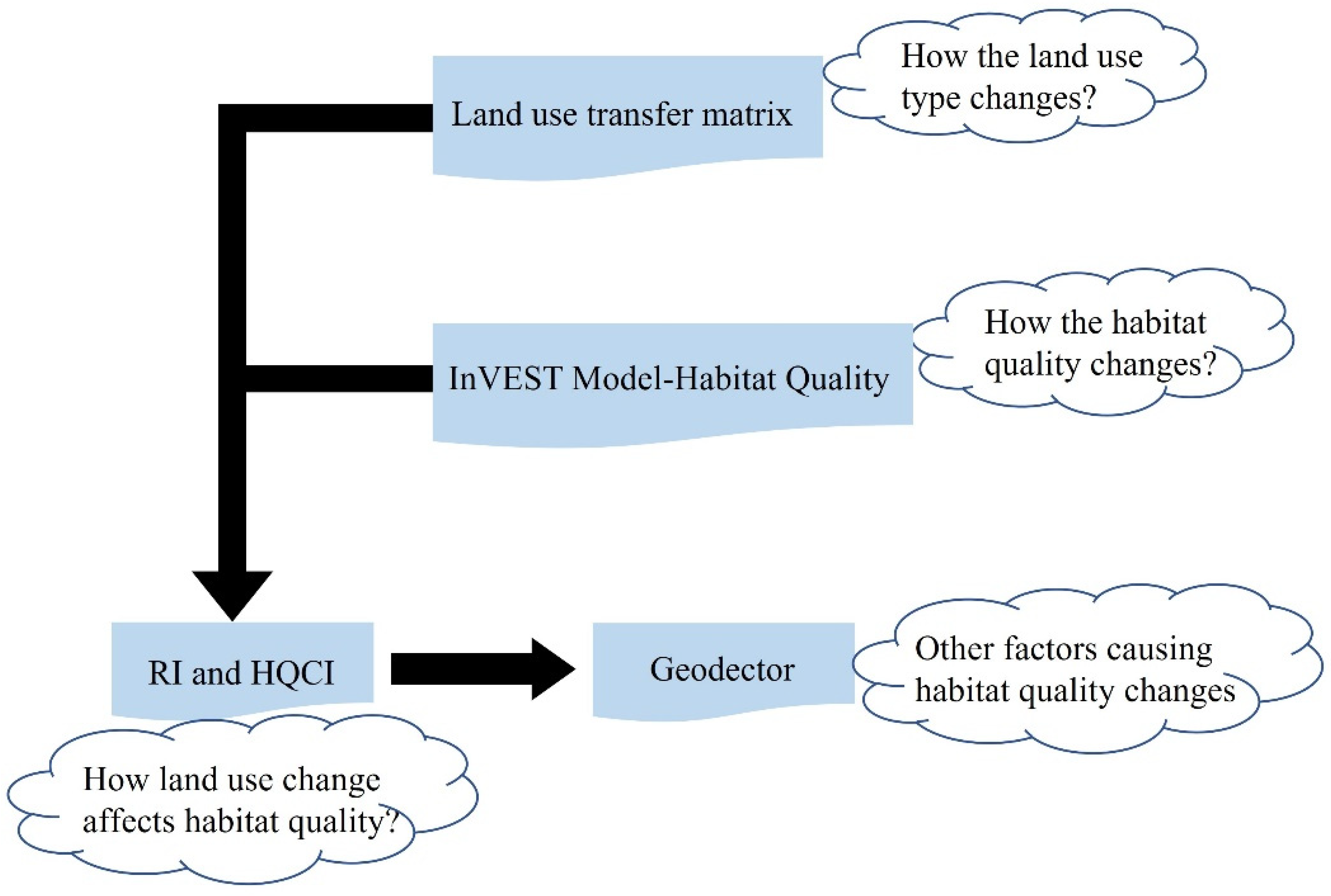
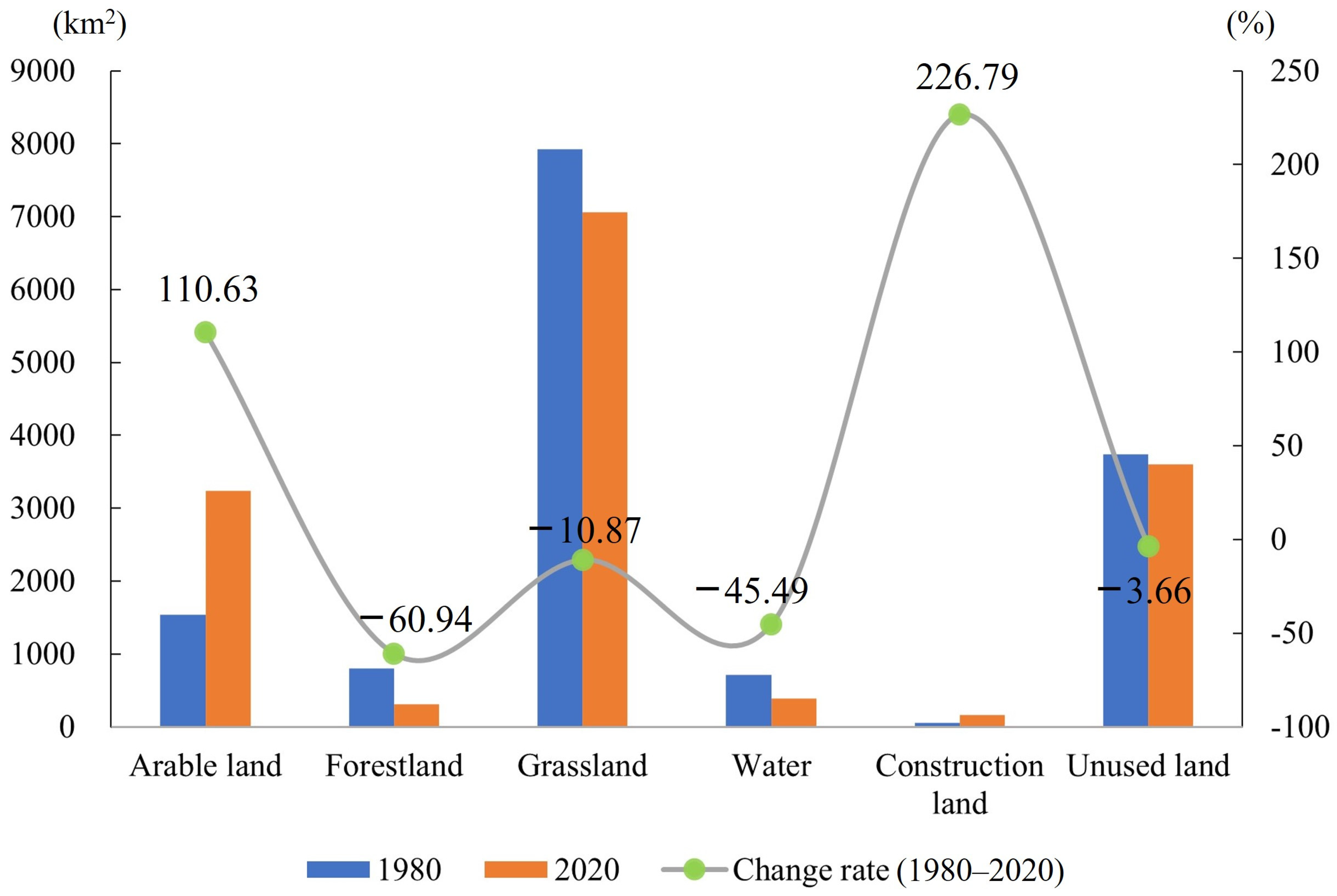
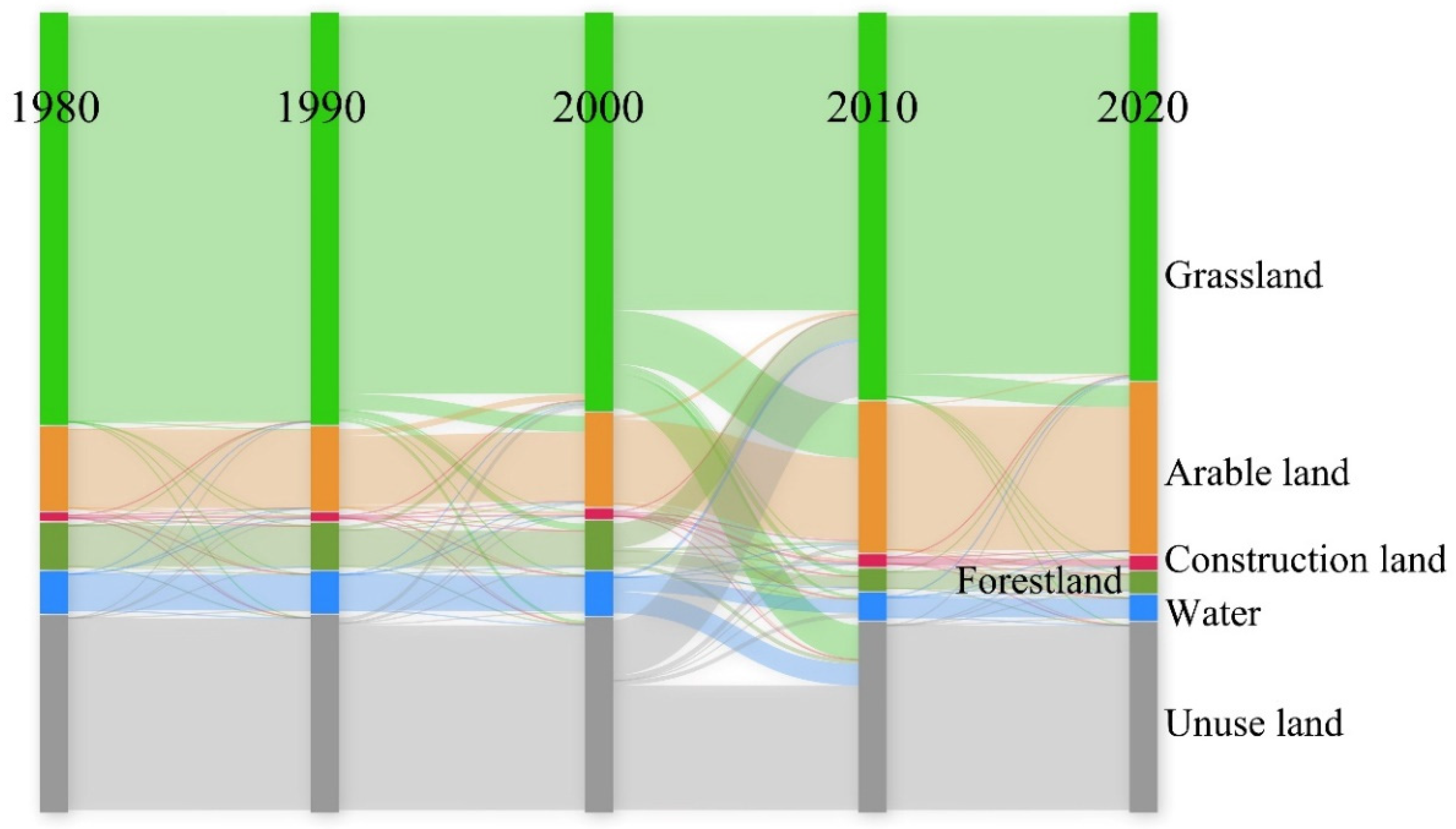
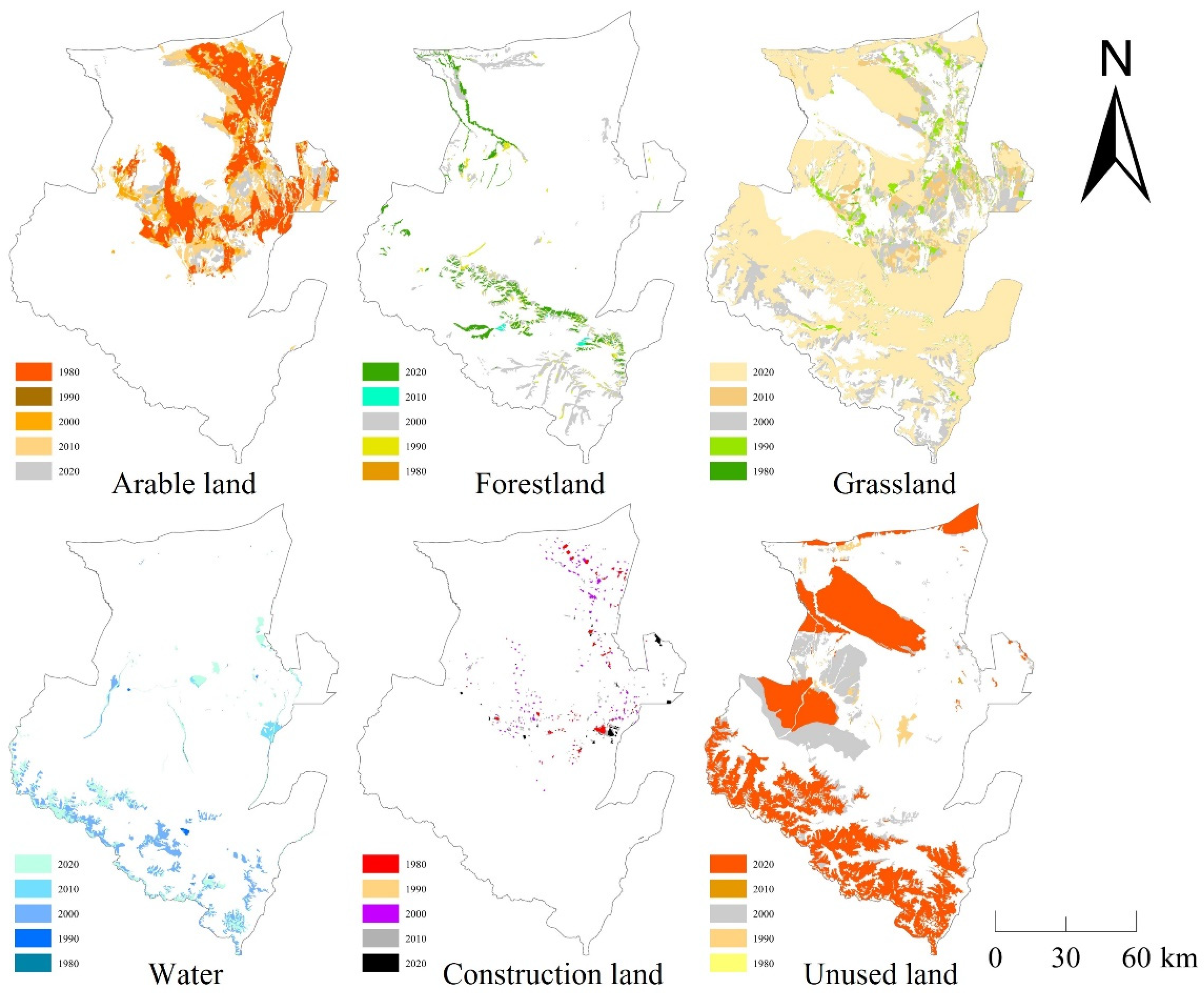
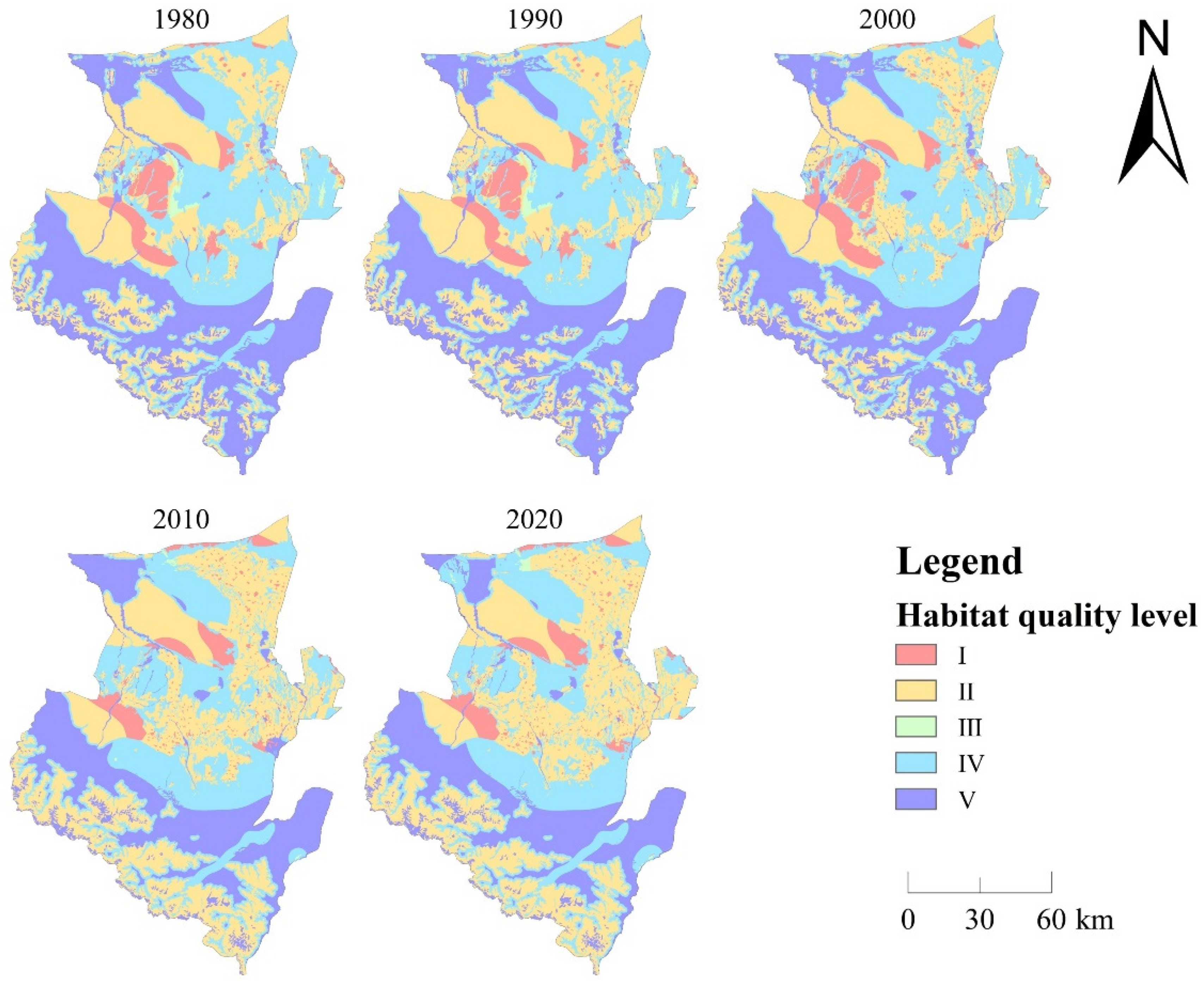


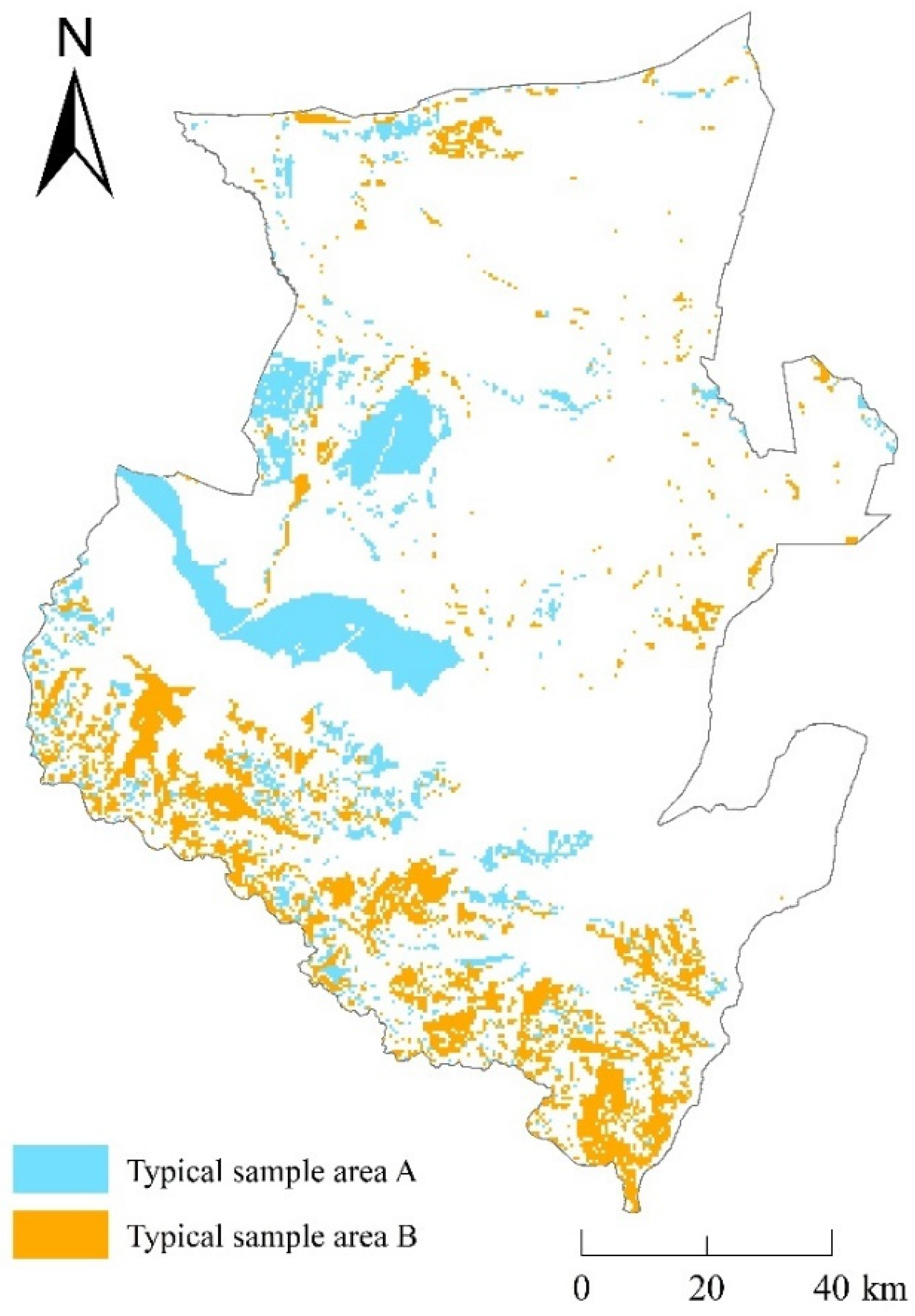
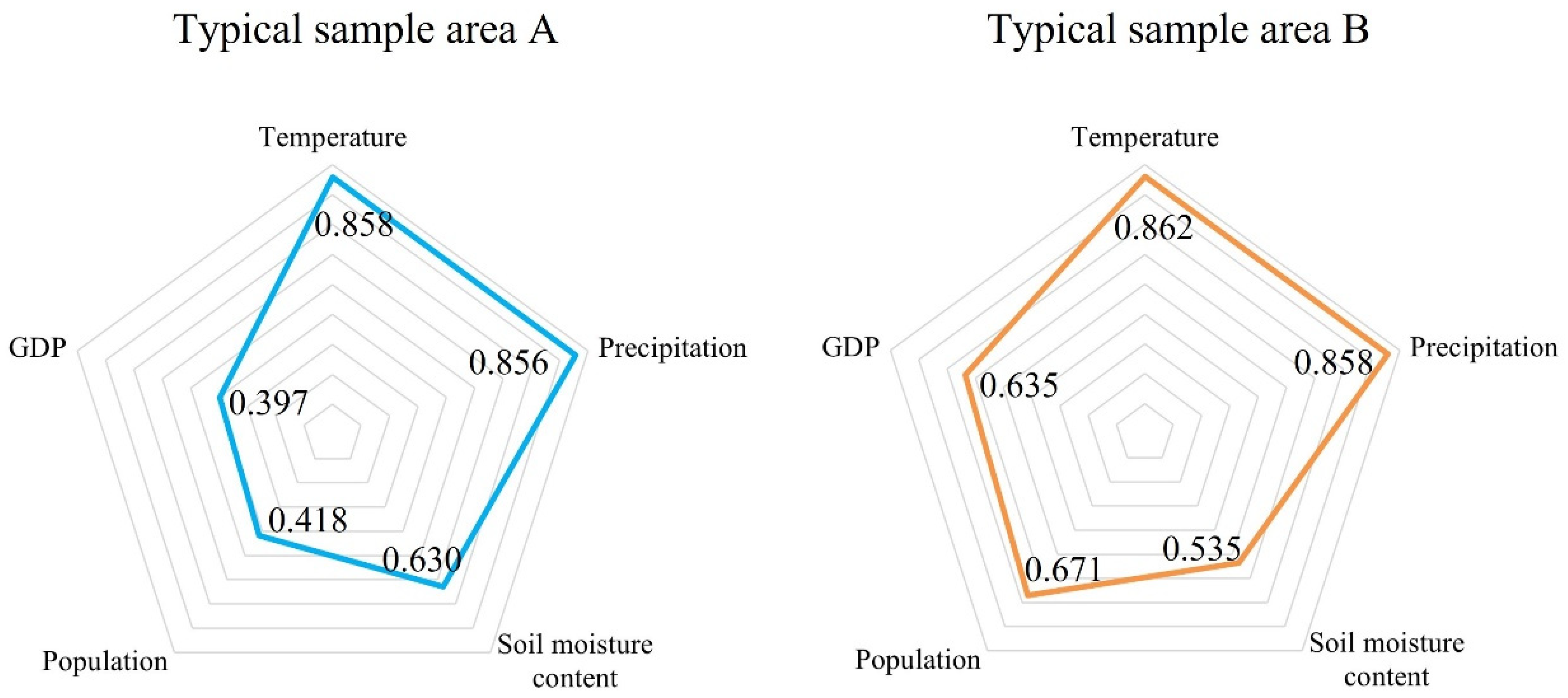
| Threat Factor | Maximum Distance/km | Weight | Spatial Decay Type |
|---|---|---|---|
| Arable land | 3 | 0.5 | exponential |
| Construction land | 6 | 0.8 | exponential |
| Unuse land | 1 | 0.4 | linear |
| Railway | 6 | 1 | linear |
| Highway | 4 | 0.8 | linear |
| National road | 4 | 0.8 | linear |
| Provincial road | 2 | 0.5 | linear |
| County road | 1 | 0.4 | linear |
| Land Use Type | Habitat Suitability | Threats | |||||||
|---|---|---|---|---|---|---|---|---|---|
| Arable Land | Construction Land | Unused Land | Railway | Highway | National Road | Provincial Road | County Road | ||
| Arable land | 0.4 | 0 | 0.9 | 0.4 | 0.5 | 0.5 | 0.4 | 0.4 | 0.3 |
| Forest land | 1 | 0.6 | 0.9 | 0.5 | 0.8 | 0.7 | 0.6 | 0.6 | 0.5 |
| Grassland | 0.8 | 0.5 | 0.7 | 0.7 | 0.6 | 0.6 | 0.5 | 0.4 | 0.3 |
| Water | 0.9 | 0.6 | 0.8 | 0.4 | 0.7 | 0.6 | 0.5 | 0.4 | 0.4 |
| Constructionland | 0 | 0 | 0 | 0 | 0 | 0 | 0 | 0 | 0 |
| Unused land | 0.2 | 0.1 | 0.1 | 0 | 0.2 | 0.2 | 0.1 | 0.1 | 0.1 |
| Time Interval | Land Use Type | Arable Land | Forest Land | Grassland | Water | Construction Land | Unused Land |
|---|---|---|---|---|---|---|---|
| 1980–1990 | Arable land | 1536.9138 | 0.0000 | 0.0585 | 0.0045 | 0.0009 | 0.0117 |
| Forest land | 0.0000 | 802.6335 | 0.0702 | 0.0027 | 0.0000 | 0.0198 | |
| Grassland | 5.0490 | 0.0738 | 7919.8083 | 0.0387 | 0.0000 | 1.4166 | |
| Water | 0.0036 | 0.0009 | 4.4505 | 705.3282 | 0.0000 | 4.7844 | |
| Construction land | 0.0036 | 0.0000 | 0.0027 | 0.0000 | 49.7277 | 0.0000 | |
| Unused land | 0.0054 | 0.0108 | 0.1278 | 0.1440 | 0.0000 | 3740.1453 | |
| 1990–2000 | Arable land | 1345.7322 | 6.2451 | 127.9926 | 2.1771 | 49.6098 | 10.2186 |
| Forest land | 19.5741 | 695.3904 | 66.8124 | 0.9243 | 0.7002 | 19.2141 | |
| Grassland | 314.7318 | 134.8398 | 7378.4097 | 31.0887 | 5.4234 | 59.8365 | |
| Water | 0.9225 | 0.0216 | 8.7993 | 693.2007 | 0.0018 | 2.5722 | |
| Construction land | 12.4101 | 0.0000 | 1.8657 | 0.0000 | 35.4528 | 0.0000 | |
| Unused land | 31.1058 | 7.4412 | 73.8252 | 29.1042 | 1.2663 | 3603.6351 | |
| 2000–2010 | Arable land | 1599.4323 | 1.3203 | 73.5633 | 6.2820 | 41.6997 | 2.1789 |
| Forest land | 56.2275 | 219.4983 | 478.5507 | 8.8767 | 1.2609 | 79.5267 | |
| Grassland | 1045.5948 | 95.3451 | 5750.0955 | 59.1417 | 31.1562 | 676.3842 | |
| Water | 3.7170 | 0.1557 | 57.8862 | 270.8964 | 0.0504 | 423.7902 | |
| Construction land | 32.5863 | 0.0000 | 2.7477 | 0.0963 | 56.7180 | 0.3060 | |
| Unused land | 99.2187 | 9.8685 | 1075.2399 | 83.2446 | 1.6938 | 2426.2110 | |
| 2010–2020 | Arable land | 2806.2702 | 0.0243 | 25.1100 | 0.0774 | 5.3433 | 0.0351 |
| Forest land | 0.0324 | 311.8581 | 14.2434 | 0.0000 | 0.0000 | 0.0540 | |
| Grassland | 424.1934 | 1.5786 | 6989.6592 | 4.4037 | 17.2386 | 1.2078 | |
| Water | 0.1359 | 0.0018 | 32.8095 | 384.1875 | 8.6400 | 2.7630 | |
| Construction land | 2.9214 | 0.0000 | 0.1431 | 0.0000 | 129.5145 | 0.0000 | |
| Unused land | 3.8367 | 0.0612 | 2.4561 | 0.8532 | 1.7883 | 3599.4195 | |
| 1980–2020 | Arable land | 1372.0221 | 1.7658 | 80.3484 | 5.0220 | 75.9942 | 1.8369 |
| Forest land | 82.1178 | 176.4603 | 453.4416 | 10.1331 | 2.6379 | 77.9355 | |
| Grassland | 1570.8834 | 121.7664 | 5434.7751 | 57.3597 | 55.7514 | 685.8522 | |
| Water | 4.1346 | 0.0288 | 69.2433 | 236.5560 | 0.0828 | 404.5221 | |
| Construction land | 24.7644 | 0.0000 | 0.7308 | 0.0639 | 23.8680 | 0.3069 | |
| Unused land | 183.4668 | 13.5027 | 1025.8758 | 80.3871 | 4.1904 | 2433.0114 |
| Arable Land | Forest Land | Grassland | Water | Construction Land | Unused Land | |
|---|---|---|---|---|---|---|
| Arable land | / | 0.5998 | 0.3991 | 0.4975 | −0.4000 | −0.2000 |
| Forest land | −0.5999 | / | −0.2000 | −0.1006 | −0.9996 | −0.7999 |
| Grassland | −0.3999 | 0.2000 | −0.0001 | 0.0994 | −0.7999 | −0.5999 |
| Water | −0.4997 | 0.1000 | −0.1002 | −0.0002 | −0.8996 | −0.6999 |
| Construction land | 0.4000 | / | 0.7990 | 0.8974 | / | 0.2000 |
| Unused land | 0.2000 | 0.7998 | 0.5998 | 0.6998 | −0.2000 | / |
| Arable Land | Forest Land | Grassland | Water | Construction Land | Unused Land | |
|---|---|---|---|---|---|---|
| Arable land | −0.0056 | 1.0590 | 32.0642 | 2.4984 | −30.3976 | −0.3674 |
| Forest land | −49.2608 | −0.0012 | −90.7008 | −1.0197 | −2.6369 | −62.3418 |
| Grassland | −628.1324 | 24.3536 | −0.5435 | 5.7018 | −44.5937 | −411.4382 |
| Water | −2.0660 | 0.0029 | −6.9350 | −0.0473 | −0.0745 | −283.1417 |
| Construction land | 9.9056 | 0 | 0.5839 | 0.0573 | 0 | 0.0614 |
| Unused land | 36.6927 | 10.8000 | 615.3484 | 56.2532 | −0.8381 | −0.0001 |
Disclaimer/Publisher’s Note: The statements, opinions and data contained in all publications are solely those of the individual author(s) and contributor(s) and not of MDPI and/or the editor(s). MDPI and/or the editor(s) disclaim responsibility for any injury to people or property resulting from any ideas, methods, instructions or products referred to in the content. |
© 2022 by the authors. Licensee MDPI, Basel, Switzerland. This article is an open access article distributed under the terms and conditions of the Creative Commons Attribution (CC BY) license (https://creativecommons.org/licenses/by/4.0/).
Share and Cite
Wei, Y.; Wang, H.; Xue, M.; Yin, Y.; Qian, T.; Yu, F. Spatial and Temporal Evolution of Land Use and the Response of Habitat Quality in Wusu, China. Int. J. Environ. Res. Public Health 2023, 20, 361. https://doi.org/10.3390/ijerph20010361
Wei Y, Wang H, Xue M, Yin Y, Qian T, Yu F. Spatial and Temporal Evolution of Land Use and the Response of Habitat Quality in Wusu, China. International Journal of Environmental Research and Public Health. 2023; 20(1):361. https://doi.org/10.3390/ijerph20010361
Chicago/Turabian StyleWei, Yiming, Hongwei Wang, Mengqi Xue, Yucong Yin, Tiantian Qian, and Fangrui Yu. 2023. "Spatial and Temporal Evolution of Land Use and the Response of Habitat Quality in Wusu, China" International Journal of Environmental Research and Public Health 20, no. 1: 361. https://doi.org/10.3390/ijerph20010361
APA StyleWei, Y., Wang, H., Xue, M., Yin, Y., Qian, T., & Yu, F. (2023). Spatial and Temporal Evolution of Land Use and the Response of Habitat Quality in Wusu, China. International Journal of Environmental Research and Public Health, 20(1), 361. https://doi.org/10.3390/ijerph20010361








